The Lynnfield Preview: Rumblings of Revenge
by Anand Lal Shimpi on May 29, 2009 1:00 PM EST- Posted in
- CPUs
SYSMark 2007 Performance
Our journey starts with SYSMark 2007, the only all-encompassing performance suite in our review today. The idea here is simple: one benchmark to indicate the overall performance of your machine.
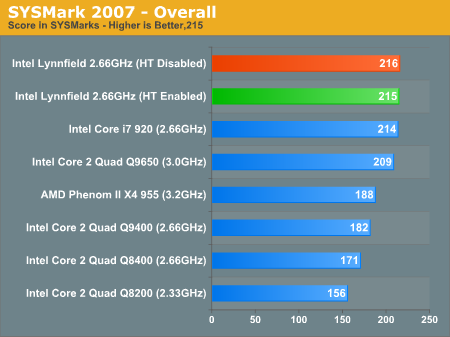
Ok. Right out of the gate, on pre-production silicon, with a pre-production motherboard and without a super aggressive turbo-mode the 2.66GHz Lynnfield sample is able to perform just as well as the i7-920. This is just as we expected given the minimal impact of triple-channel DDR3 on i7 that we pointed out in our original review.
Curiously enough, HT doesn't seem to do anything at all for Lynnfield in this test. Remember that stressing four cores is tough enough, finding eight CPU intensive threads is even more difficult.
Adobe Photoshop CS4 Performance
To measure performance under Photoshop CS4 we turn to the Retouch Artists’ Speed Test. The test does basic photo editing; there are a couple of color space conversions, many layer creations, color curve adjustment, image and canvas size adjustment, unsharp mask, and finally a gaussian blur performed on the entire image.
The whole process is timed and thanks to the use of Intel's X25-M SSD as our test bed hard drive, performance is far more predictable than back when we used to test on mechanical disks.
Time is reported in seconds and the lower numbers mean better performance. The test is multithreaded and can hit all four cores in a quad-core machine.

DivX 8.5.3 with Xmpeg 5.0.3
Our DivX test is the same DivX / XMpeg 5.03 test we've run for the past few years now, the 1080p source file is encoded using the unconstrained DivX profile, quality/performance is set balanced at 5 and enhanced multithreading is enabled:
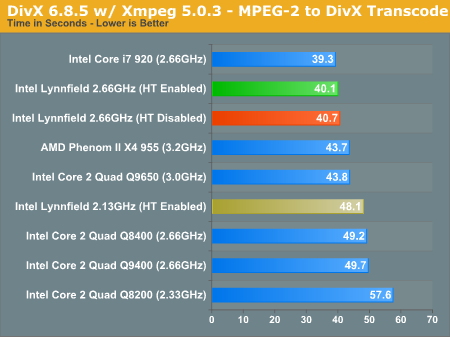
Once more, we see very little impact from Hyper Threading; the entry level Lynnfield may not be as bad as you'd think. On top of that, the crippled Lynnfield is less than 4% slower than the Core i7-920. Enable its aggressive turbo mode and I believe we'll have a chip that can actually beat, even if only slightly, the Core i7-920.
x264 HD Video Encoding Performance
Graysky's x264 HD test uses the publicly available x264 codec (open source alternative to H.264) to encode a 4Mbps 720p MPEG-2 source. The focus here is on quality rather than speed, thus the benchmark uses a 2-pass encode and reports the average frame rate in each pass.
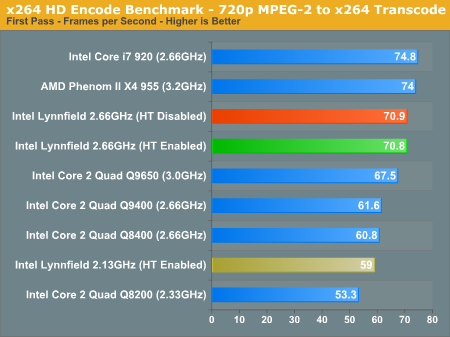
The x264 encode test shows one application where Hyper Threading is important. A 2.13GHz Lynnfield with HT enabled is faster than a 2.66GHz Lynnfield with HT disabled, unfortunately the former isn't on the roadmap and the latter is what we're getting.
Without HT enabled the $196 Lynnfield 2.66GHz core is faster than every non-EE Penryn Core 2 Quad as well as AMD's Phenom II X4 955 (in the second pass of the test). The i7-920 is significantly faster thanks to having HT enabled; and now we have the perfect reason for Intel disabling HT on the "low end" Lynnfield.
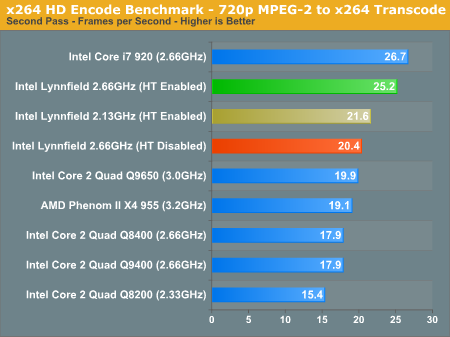
Windows Media Encoder 9 x64 Advanced Profile
In order to be codec agnostic we've got a Windows Media Encoder benchmark looking at the same sort of thing we've been doing in the DivX and x264 tests, but using WME instead.
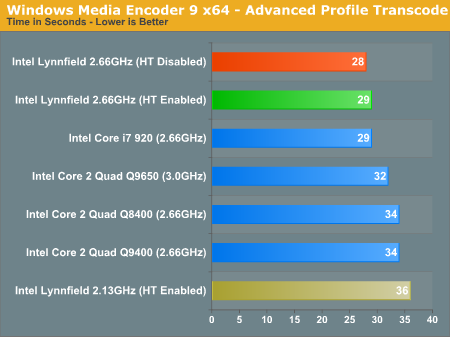
Tests that don't scale well with HT enabled, once again, show no performance difference between a 2.66GHz Lynnfield and a 2.66GHz Bloomfield.










95 Comments
View All Comments
TA152H - Saturday, May 30, 2009 - link
Actually, Jarrod, your logic is flawed.AMD does that triple core and dual core so they can salvage processors that would be thrown out. Also, dual core can be faster than quad, since you can generally clock higher, since you have less heat and your limit is only the slowest of two cores, not four. But, in any event, there are a lot of instances where going to four cores is not going to help much. The Lynnfield is slower in a lot more things.
You're also confused about dual-channel and tri-channel. I never said dual-channel was bad, I said Lynnfield was. The i7 with dual channel performs better than the Lynnfield, so don't get the two confused.
The difference in performance between the i7 and Lynnfield is dramatic considering they are the same except for the memory controller. Anyone here who buys a Lynnfield is probably making a mistake, since it's easy to overclock the i7, and you can't fix the brain-damaged Lynnfield.
What your saying is what I have been. Stick with the i7 and let it go down in price, instead of crippling it and selling that as the lower cost part. Where I disagree with you is, I don't think the i7 platform is going to be much less expensive to make. Maybe you have the sizes for all the parts, but I don't think you'll see a significant difference in the costs. A lower end chipset without so many PCIe lanes for the i7 could have brought the system costs a lot closer, and you wouldn't have to castrate the processor.
Also, because now you have more functions on the processor, it's very possible it will not clock as high. It will, after all, generate more heat, presumably, since it's got more on it.
I don't think Intel made a good compromise with this. To lose so much performance with just a memory controller change is shocking to me. Maybe it's new silicon, and maybe that's most of the performance loss, but it doesn't make sense to me. It's not the same as a smaller L2 cache that makes the processor a lot smaller. Or salvaging processors that would otherwise be thrown out, where there is a very meaningful cost difference. This seems more like a market segment type of thing.
JarredWalton - Saturday, May 30, 2009 - link
I think you're putting WAY too much emphasis on these early benchmarks. I expect final Lynnfield to perform faster than the i7-920 in most cases (outside of heavily threaded workloads like 3D rendering). There are tons of people that:A) Never do 3D rendering
B) Never do video encoding/transcoding
C) Never overclock
For those users, the enhanced Turbo on Lynnfield combined with lower costs makes perfect sense. We are after all looking at a platform cost that will be about $150 less than Core i7 + mobo, plus you buy RAM in pairs instead of triplets.
We'll have to see how Lynnfield clocks with final CPUs before making any judgments; I certainly don't think the sample Anand has is representative of final chips in performance, clocking, or various other areas. As he mentions, the motherboard BIOS releases still look like they're not ready for the public, and that can make up for the "huge" 5% performance gap.
For people looking at faster dual-core chips for gaming (i.e. Core 2 Duo E8500/E8600), I suspect that the Lynnfield will outperform them across the board, with or without overclocking. They'll be about the same price too, all told.
GeorgeH - Friday, May 29, 2009 - link
When the "real" test comes out, I'd be very curious to hear your thoughts on the USB, SATA, and PCIe 3.0 standards, as all three have been rumored to be out in late 2009 or early 2010. With PCIe 2.0 integrated onto the CPU and USB/SATA 2.0 being locked in on the motherboard (ignoring add-on cards) it seems as if first gen systems could end up being a major loser in terms of longevity and upgradeability.jmke - Friday, May 29, 2009 - link
When I got to the last page and started reading the Why would anyone want a LGA-1366 system then? , I got a nasty flashback. S939 vs S754: we all knew S754 was a dead end, right from the start; why o why is Intel taking this same decisions? Build one platform, let it scale all the way up and down; why force people to upgrade motherboard to upgrade their CPU :-/philosofool - Saturday, May 30, 2009 - link
Because you and I, the DIY system builders, represent about 0.3% of the market for computers. Socket decisions are driven entirely by the needs of Intel, Dell, HP and the rest of the network of manufactures. Those people want an inexpensive successor to LGA 775, which 1366 was not. I'm not sure why intel wanted a performance socket, but I don't think 1366 is leaving the scene. It will just be part of the "high end" market. LGA 1156 will include mainstream parts eventually. However, looking at the cost of Core i5, I have to say that I'm probably not canceling my plan to upgrade to a Phenom X3 720.Depeche - Friday, May 29, 2009 - link
If it wasn't for AMD Intel would just price their processors whatever they want it to be. AMD is out there so that Intel drops their prices :)lopri - Friday, May 29, 2009 - link
is what Intel wants, obviously. And it is succeeding. More sockets, more patents, more incompatibility... and We're going back to $200, $500, $1,000 tiers in CPU prices. I'm surprised that you have no complaint, Anand. Well, actually you think the opposite! (Page 2: Making Nehalem Affordable??) Wow!Umm..? I thought PCH was just a new name for ICH. Is there any other functionality in PCH that does not exist in ICH?
Apparently Intel saw the danger of 3rd party PCBs for Lynfield CPUs, and that is why these CPUs are priced so high despite being designated as "Mainstream". (Though I am certain Intel will do anything it can to prevent 3rd party to develop motherboards for these CPUs - at least until DOJ threatens it with anti-trust investigations)
Forgetting all the dirty business stuff, Lynfield is no doubt an admirable piece of silicon. It is a fine engineering that no one else has achieved yet. I'm anxious to get my hands on it when it's out. I have an i7 920 sitting in a box for nearly two weeks now because I can't seem to find a board that suits my needs/wants. I hope we'll see variety of creative motherboards for Lynfield CPUs now that these CPUs aren't (presumably) shackled to QPI BS.
Anand Lal Shimpi - Friday, May 29, 2009 - link
Note that these are performance desktop parts. They are mainstream for quad-core CPUs but not designed for the sub-$500 system market. You will see 32nm Westmere derivatives in the $100 - $200 range and eventually even lower.Third party motherboard makers already have P55 boards in development for Lynnfield, the majority of P55 boards for Lynnfield won't be made by Intel.
Take care,
Anand
Kary - Friday, May 29, 2009 - link
I think this was more a reference to third party CHIPSETSLike Nvidia's ION upset Intel
Different manufactures using the same chipset don't really make that different of boards (compared to completely different chipsets made into boards by different manufacturers)
Anand Lal Shimpi - Friday, May 29, 2009 - link
The chipset honestly doesn't do much these days. It acts as a PCIe switch and delivers basic standards: USB, SATA, GigE, etc... Long term I think we'll see that AMD makes AMD chipsets and Intel makes Intel chipsets, I don't see much room for someone like NVIDIA there.Where NV does add value is in graphics, and there's nothing preventing NVIDIA from continuing to deliver graphics to both Intel and AMD platforms. I don't believe we'll see much of a future in 3rd party integrated graphics chipsets on either AMD or Intel platforms, both manufacturers will be bringing graphics on-package.
At this point I view NVIDIA's platform strengths as being predominantly in mobile applications (think MIDs, smartphones, notebooks) and unfulfilled niches like Atom + Ion. On the graphics side, NVIDIA is quite strong, it's just the platform strength that has eroded over time.
Take care,
Anand